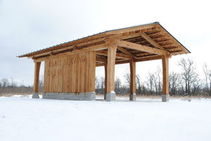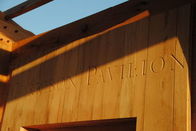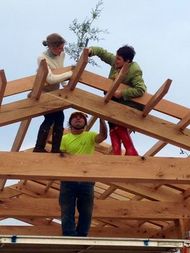Although currently under a layer of snow, come spring the Notre Dame Linked Experimental Ecosystem Facility (ND-LEEF) will open a brand new outdoor classroom and research destination, the Morrison Family Education and Outreach Pavilion.
Science Serving Society
ND-LEEF is a research facility within the Notre Dame Environmental Change Initiative, which supports innovative research programs that help solve complex environmental problems, including the interrelated problems of invasive species, land use, and climate change and their synergistic impacts on freshwater. Based in South Bend’s St. Patrick’s County Park, ND-LEEF is a globally unique research site due to its two replicated watersheds that each contain linked streams, ponds, and wetlands. These watersheds provide a platform for cutting-edge environmental research in a setting that mimics nature, yet is highly controlled and replicable.
“ND-LEEF will be critical in solving the world’s major environmental challenges by bridging the gap that has traditionally existed between the lab and the field,” said Jennifer Tank, Galla Professor of Biological Sciences, Director of ND-LEEF, and Interim Director at ND-ECI. “From identifying invasive species through their environmental DNA to predicting nutrient retention from agricultural run-off in bodies of water, ND-LEEF truly is using science to serve society.”

The new Morrison Family Education and Outreach Pavilion at ND-LEEF will translate the research done in the fields and streams to anyone interested in the ecological research, including members of the public, researchers, and students, ranging from children to adult-learners. It will also help raise awareness among community members about issues related to environmental change and sustainability, especially given its central location within a popular county park, and will serve as a critical bridge between the classroom and the field for students of all ages.
Sustainability in Design
The Morrison Pavilion was designed by Notre Dame’s Aimee Buccellato, Project Designer for ND-LEEF and Assistant Professor in the School of Architecture. She designed the pavilion to be a place to learn about important issues related to the environment and sustainability. It also serves as a full-scale example of how sustainable design and construction practices can minimize society’s impact on the environment. Speaking about the design of the pavilion, Buccellato said, “By sourcing minimally processed, local building materials and utilizing durable traditional timber framing construction techniques, the Morrison Family Education and Outreach Pavilion is a structure that embodies Notre Dame’s commitment to solving the world’s most pressing environmental problems and it will represent Notre Dame’s legacy in science and education for years to come.”

The timber for the frame, mostly native white and burr oak, was felled in western Illinois and transported for milling and fabrication to Trillium Dell Timberworks. The Trillium Dell Timberworks team traveled to ND-LEEF in mid-October to raise the frame, a live-build event that was shared with 80 fourth graders from Madison Primary Academy in South Bend and 30 Notre Dame Architecture graduate and undergraduate students.

The pavilion includes a demonstration wall, which is outfitted with a cutting-edge touch screen donated by Corning and the Martin Curran Family. It will exhibit information about the research underway at ND-LEEF using interactive multimedia displays that will translate Notre Dame research to the public, as well as tell the story of building the distinctive pavilion with its traditional timber frame construction methods. The media components will be powered by advanced photovoltaic solar cells mounted to the roof of the pavilion and the interactive touch screen display will allow visitors to learn about solar power technology and the daily power generation of the pavilion.
Looking Ahead to Spring
Come spring and snow melt, Notre Dame researchers from the Colleges of Science and Engineering will return to the field to conduct research and host student field labs on groundwater hydrology, stream ecology, and DNA transport in streams, while the School of Architecture’s GreenScale Research team will also use the design and construction data collected on the pavilion to conduct a cradle-to-site Life Cycle Analysis of the structure that will be used as a teaching tool for describing the broader environmental impacts of design and construction. Results from the Life Cycle Analysis will also be accessible through the touch screen software.

The ND-LEEF facility is wired with an extensive embedded sensor network, whereby interested members of the public, school groups, or collaborating scientists will soon be able to follow the research online. With a plan for eight to ten additional linked watersheds, the scientific utility of ND-LEEF will greatly increase, allowing more robust experiments and serving a larger group of scientists who can address the grand environmental challenges of our time.